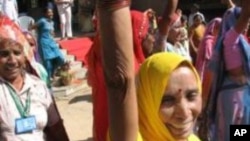India's first Prime Minister once said, "You can tell the condition of a nation by looking at the status of its women."
With that in mind, Jawaharlal Nehru's quote puts India in critical condition.
Despite being one of the fastest growing economies in the world and producing a surplus of food, India is ranked number 67 among 84 countries listed in the 2010 Global Hunger Index issued Monday by the International Food Policy Research Institute.
It ranks well behind China, which is listed at number nine, while neighboring Pakistan is fifty second on the list. India even ranks behind countries in sub Saharan Africa on the index.
“India has the largest number of hungry children in the world”, says John Coonrod, Executive Vice President of the Hunger Project, a globally based, non-profit, organization whose self proclaimed aim is the sustainable end of world hunger.
Coonrod quoted a UNICEF study in 1996 that said the only reason the rates of malnutrition in South Asia are so high is the subjugation of woman in society.
That results of that study have been repeated many times, including last year's Global Hunger Index report, in which Agnes Quisumbing, report co-author and International Food Policy Research Institute senior research fellow writes “In South Asia, women’s low social status and limited access to schooling have dire consequences for the nutrition, health, and well being of both mothers and their children.”
The Hunger Project's Coonrod says “Some of these women have been so marginalized that they have not even heard their names spoken. It affects the health of both the women and their children."
“Discrimination against girls and women results in girls being breast fed for less time than boys so that hopefully, the mother can become pregnant again and have a boy," said Coonrod, who said "Girls are taught to eat less and least, they are married too young and have children when they, themselves are too young and malnourished. So this cycle of malnutrition that is caused by gender discrimination gets perpetuated from generation to generation.”
Coonrod says there are good answers to the situation. He said one has been a constitutional amendment passed by India in the nineties guaranteeing that a third of the seats in village councils would be held by women.
He says this has lead to changes that continue to accelerate as woman become more and more effective in leadership positions despite reports of increased violence against women in India. However, Coonrod says opposition to women in leadership positions is decreasing as the population sees how woman are proving themselves as leaders.
Several of the states in India, says Coonrod, have felt so good about empowering women that they have increased the percentage of women officials from one third to one half. So, says Coonrod, “there is real evidence that things are changing and changing rapidly.”










